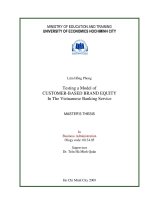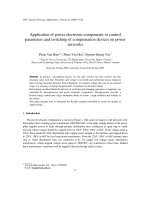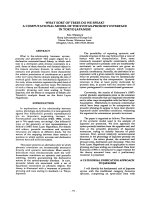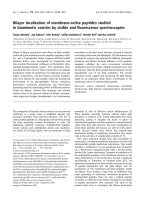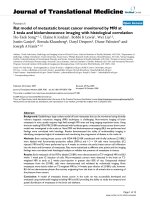Dynamic electro thermal model of power electronic building block in micro grid modeling, analysis and simulation
Bạn đang xem bản rút gọn của tài liệu. Xem và tải ngay bản đầy đủ của tài liệu tại đây (1.94 MB, 161 trang )
DYNAMIC ELECTRO-THERMAL MODEL OF
POWER ELECTRONIC BUILDING BLOCK IN MICRO
GRID: MODELING, ANALYSIS AND SIMULATION
HUANHUAN WANG
NATIONA L UNIVERSITY OF SINGAP ORE
2012
DYNAMIC ELECTRO-THERMAL MODEL OF
POWER ELECTRONIC BUILDING BLOCK IN MICRO
GRID: MODELING, ANALYSIS AND SIMULATION
HUANHUAN WANG
(M.Eng(Hons.), B.Eng, Xi’an Jiao Tong Univ., Xi’an, China)
A THESIS SUBMITTED
FOR THE DEGREE OF DOCTOR OF PHILOSOPHY
DEPARTMENT OF ELECTRICAL & COMPUTER
ENGINEERING
NATIONAL UNIVERSITY OF SING APORE
2012
i
Acknowledgment
I would like to express my sincere gratitude to my supervisor, Dr. Ashwin
M. Khambadkone, for his guidance and inspiration during the progress of my
research. He influenced me with something beyond the academic knowledge. The
most impo r tant and valuable things I learned from him are the life-long learning
spirit for the excellence, rigorous attitude towards research, and the persistent
positive attitude. These spirits will benefit me for my future career as well.
I sincerely thank Dr. Birgersson Karl Erik for his generous guidance on
the software application in multi-disciplinary research and advice on my paper
writing.
I also thank Dr. Dipti Srinivasan, Dr. Sanjib K. Panda, and Dr. Chang
Che-Sau, for serving as my Ph.D thesis committee members. Dr. Dipti was also
one of my Ph.D Q ualification Exam committee members. Her positive feedback
and insightful comments gave me great confidence to continue my research.
ii
I would like to thank Department of Electrical & Computer Engineering for
providing research scho larship and all kinds of supports during the past years,
and thank Modular Distributed Energy Resource Network (MODERN) project
funded under A*STAR SERC IEDS programme, for providing me with the re-
search facilities.
My warm thanks are expressed to Electrical Ma chines and Drives (EMD)
Lab officers, Mr. Woo, and Mr. Chandra, for their readiness to help on any
matter. Their ever smiling faces always cheer me up. My special thanks go to
Dr. Zhou Haihua for her help and encouragement. Besides, I want to thank all
my fellow research scholars in EMD lab for their accompany and supports, in one
way or another.
Last but not least, I would like to thank those closest to me, my parents and
elder brother. I am greatly indebted to them for making me capable to pursue
this task. Words cannot express my deepest gratitude for their understanding,
encouragement, and confidence in me. I would like to dedicate this thesis to
them.
i
Contents
Acknowledgement i
Summary v
List of Tables viii
List of Figures x
List of Acronyms xiv
List of Symbols xvi
1 Introduction 1
1.1 Research Background and Motivation . . . . . . . . . . . . . . . . 3
1.2 Problem Formulation . . . . . . . . . . . . . . . . . . . . . . . . . 9
ii
1.3 Literature Review . . . . . . . . . . . . . . . . . . . . . . . . . . . 10
1.3.1 Power Losses Calculations . . . . . . . . . . . . . . . . . . 11
1.3.2 Thermal Analysis . . . . . . . . . . . . . . . . . . . . . . . 14
1.4 Major Contributions . . . . . . . . . . . . . . . . . . . . . . . . . 23
1.5 Organization of the Thesis . . . . . . . . . . . . . . . . . . . . . . 26
2 Design of PEBB-based Power Electronics System 28
2.1 Introduction . . . . . . . . . . . . . . . . . . . . . . . . . . . . . . 29
2.2 Investigated Converter Topologies in PEBB Design . . . . . . . . 31
2.3 Proposed Comprehensive Power Loss Calculation Solution . . . . 35
2.3.1 Analytical Power Losses Distribution for Semiconductor
Devices . . . . . . . . . . . . . . . . . . . . . . . . . . . . 35
2.3.2 Transformer Power Losses Evaluations . . . . . . . . . . . 48
2.4 Efficiency Comparisons and Result Discussions . . . . . . . . . . . 54
2.5 Summary . . . . . . . . . . . . . . . . . . . . . . . . . . . . . . . 57
3 Dynamic Electro-Thermal Modeling for PEBB-based Power Stage 58
3.1 Introduction . . . . . . . . . . . . . . . . . . . . . . . . . . . . . . 59
iii
3.2 Methodology of the Proposed Dynamic Electro-Thermal Model . 63
3.3 Implementation of the Proposed Electro-Thermal Model . . . . . 66
3.3.1 Improved Power Loss Distribution Modeling . . . . . . . . 66
3.3.2 Comprehensive Thermal Modeling . . . . . . . . . . . . . . 72
3.4 Results Analysis and Conclusio ns . . . . . . . . . . . . . . . . . . 85
3.4.1 Temperature Prediction under Nor mal Operation . . . . . 85
3.4.2 Temperature Prediction in Short Circuit Conditions . . . . 87
3.5 Summary . . . . . . . . . . . . . . . . . . . . . . . . . . . . . . . 92
4 Application of PEBBs in Hybrid Micro Grid 93
4.1 Introduction . . . . . . . . . . . . . . . . . . . . . . . . . . . . . . 94
4.2 Roles of Dynamic Electr o-Thermal Modeling in Parallel Operation
of PEBBs . . . . . . . . . . . . . . . . . . . . . . . . . . . . . . . 95
4.3 Applications o f Dynamic Electro-Thermal Model in PEBBs Con-
figuration System . . . . . . . . . . . . . . . . . . . . . . . . . . . 98
4.3.1 Case Study of PEBBs Parallel Operation . . . . . . . . . . 98
4.3.2 Analysis on the Improvement of the Over Current Carrying
Ability . . . . . . . . . . . . . . . . . . . . . . . . . . . . . 99
4.4 Summary . . . . . . . . . . . . . . . . . . . . . . . . . . . . . . . 114
iv
5 Conclusion & Recommendation for Future Work 116
5.1 Conclusion . . . . . . . . . . . . . . . . . . . . . . . . . . . . . . . 118
5.2 Recommendations for Future Works . . . . . . . . . . . . . . . . . 119
Bibliography 123
v
Summary
To interconnect the micro grid (MG) with electric power system (EPS),
power electronic converters play vital roles. As a set of parallel connected mod-
ular converters, Power Electronics Building Block (PEBB), owns advantages in
power capability, efficiency for high current application and merits such as reliabil-
ity, redundancy for low cost maintenance and upg r ade. Thermal management is
a critical problem in the PEBB design procedure, where the power losses distribu-
tion and heat generated in the modules dramatically increase with the increasing
of the switching frequency.
The aim of the thesis is to build a dynamic electro-thermal model, includ-
ing temperature dependent power loss calculation and a comprehensive thermal
model. The focus is to develop t he theoretical framework and supporting too l fo r
modeling, analysis and simulation (MAS) of the PEBB dynamic electro-thermal
model. This model is proved to possess the accuracy of Finite Element Method
(FEM) and also makes use of the convenience of resistor capacitor (RC) network
vi
considering the easy coupling with electric circuit.
Power losses modeling of semiconductor devices has firstly been analyzed.
The accurate power losses model can help in evaluating the efficiency o f different
converter topologies and thus help to select the switching devices and suitable
converter topolo gy.
Based on the ab ove power losses modeling, a dynamic electro-thermal method-
ology has then been proposed and an iterative algorithm has also been propo sed
to implement the dynamic electro-thermal modeling in PEBB applications. To
achieve requirements for the modeling, an improved power loss distribution with
temperature dependent self-improvement ability and an effective RC thermal
modeling have been respectively proposed to implement the modeling. The ther-
mal model can provide junction temperature predictions not only in normal op-
eration conditions, especially under high current condition, but also in different
short circuit conditions. The associated thermal analysis procedure can also be
used to estimate power cycle of the semiconductor devices and help to improve
the life time of the devices. The proposed dynamic electro-thermal model is play-
ing vital roles in the design and simulation of PEBB systems, requiring thermal
control and efficiency improvement.
The dynamic electro -thermal model developed in this thesis can be used
in many applications, which is especially applied in an intelligently scheduled
vii
PEBBs parallel operation system connected in micro grid. The simulation and
analysis is addressed to two types of operation circumstances, including normal
operation and over loading o peration. The results well prove the significance and
effectiveness of the dynamic electro -thermal modeling for the intelligent opera-
tions of PEBBs in distribution energy resources.
All modeling methodolog ies, a nalysis, and simulation algorithms proposed
and realized, using MATLAB/ Simulink and multi physics software COMSOL,
throughout the course of development have been thoroughly verified together
with Manufacture datasheets or IEEE Standards.
viii
List of Tables
1.1 Equivalence between the Thermal Model and Electrical Model. . . 18
2.1 Basic Switching States in 5L-SCHB. . . . . . . . . . . . . . . . . . 33
2.2 Specifications for Converter Design. . . . . . . . . . . . . . . . . . 33
2.3 Basic Switching States in 5L-HB with coupled inductor. . . . . . . 35
2.4 Coefficients of the Kaschke Ferrite Materials @ 100
◦
C. . . . . . . 52
2.5 Transformer Specification. . . . . . . . . . . . . . . . . . . . . . . 53
2.6 Transformer Loss Distribution. . . . . . . . . . . . . . . . . . . . . 54
2.7 Power Semiconductor Devices’ Specifications. . . . . . . . . . . . 55
3.1 Physical Parameters [1]. . . . . . . . . . . . . . . . . . . . . . . . 76
3.2 Parameters of Transient Thermal Impedance Depicted in (3.18) . . 81
3.3 Equivalence between the Thermal Model and Electrical Model. . . 82
3.4 Parameters for the Transient Thermal Impedance Z
ja
in Fig. 3.10.
Take IGBT1 for example, the Diode can be derived similarly.
T
amb
=300K. . . . . . . . . . . . . . . . . . . . . . . . . . . . . . . 83
ix
4.1 Relationship between maximum arriving temperature T
x
and ini-
tial temperature T
1
, over current duration time ∆t
b
. (T
max
= 60
◦
C) 112
4.2 Relation between the expanded over current car rying duration and
arriving temperature T
x
. (T
max
= 60
◦
C, T
1
= 40
◦
C) . . . . . . . . 113
x
List of Figures
1.1 An Example of Micro Grid Configuration. . . . . . . . . . . . . . 3
1.2 Conceptual Structure of Hybrid MG with Paralleled PEBBs System. 5
1.3 One Example of PEBB Application System. . . . . . . . . . . . . 6
1.4 Illustration of PEBB Concept. . . . . . . . . . . . . . . . . . . . . 7
1.5 Switching Energy Curve of CM1000HA-2 4H. . . . . . . . . . . . . 12
1.6 Illustration of One Dimensional Hea t Transfer. . . . . . . . . . . . 16
1.7 Design Scheme of PEBB-based Power Electronics System. . . . . 25
2.1 Schemes of Converter Topologies for PEBB Applications. . . . . . 32
2.2 Output Current and Voltage of 5L-SCHB. . . . . . . . . . . . . . 34
2.3 Output Current and Voltage of 5L-HB with Coupled Inductor. . . 36
2.4 Piecewise Linearizing Cha r acteristics of IGBT & Diode. . . . . . . 37
2.5 Scheme of Duty Ratio. . . . . . . . . . . . . . . . . . . . . . . . . 38
2.6 Switching Characteristics of IGBT and Diode. . . . . . . . . . . . 39
xi
2.7 The Influence of the Induced a and b. . . . . . . . . . . . . . . . . 43
2.8 Power Losses Distribution in 3L-HB. . . . . . . . . . . . . . . . . 47
2.9 Relations between Losses Distribution & Converter Variables. . . 49
2.10 Schemes of Investigated Converter Topologies with Transformer. [2] 50
2.11 Relation between Depth and Frequency. . . . . . . . . . . . . . . 53
2.12 Efficiency Comparison of the three Converter Topologies under
Different Load Conditions. . . . . . . . . . . . . . . . . . . . . . . 56
2.13 Comparison of Power Loss Distribution among the three Different
Topologies. . . . . . . . . . . . . . . . . . . . . . . . . . . . . . . 56
3.1 Typical Junction Temperature Profile of Semiconductor Device. . 60
3.2 Semiconductor Power Cycling Result. [3] . . . . . . . . . . . . . 62
3.3 Implementation of Dynamic Electro-thermal Coupling. . . . . . . 64
3.4 Flow Chart of Proposed Electro-thermal Modeling Algorithm. . . 65
3.5 Overall Thermal Network Model. k denotes variables for the k
th
semiconducto r switch, P
total
is the total power loss, Z
jc
is the ther-
mal impedance f rom junction to case, Z
ch
is the thermal impedance
form case to heat sink, and Z
hs
is the heat sink thermal impedance. 74
3.6 Structure View of IGBT Module SKW75GB176D with DBC. All
the values are in unit (mm). . . . . . . . . . . . . . . . . . . . . . 75
3.7 Temperature Distribution for IGBT Module SKW75GB176D. The
two IGBT chips are heated by 17.95 W, and the two Diode chips
are heated by 13.98 W. The ambient temperature is 27
◦
C. . . . . 79
3.8 Transient Thermal Impedance for IGBT Chip and Diode Chip.
The rated curves are from manufacture’s Datasheet, and the curves
via FEM are post-processed in COMSOL. . . . . . . . . . . . . . 80
xii
3.9 Fo ster RC Network. Taking IGBT1 (T
1
in Fig . 2.1(a)) as an ex-
ample, other IGBTs and Diodes have the similar structure. . . . . 82
3.10 Comprehensive RC Thermal Equivalent Circuit. Taking IGBT1 as
an example, other IGBTs and Diodes have the similar structure. . 83
3.11 Summary of the Comprehensive Thermal Modeling Procedure. . 84
3.12 Output Current Sharing of the Paralleled Power Converter Modules. 86
3.13 Numerical Simulation of the Time Behavior of the Junction Tem-
peratures of IGBT 1 and Diode 1. . . . . . . . . . . . . . . . . . . 87
3.14 Comparison Results of Temperature Predictions under Different
Output Peak Current Values. Taking IGBT1 as an example, (—
—) (–.–.–) ( ) are for the temperature curves without improved
comprehensive thermal model. (——) (– △ –) ( ✩ ) are
for the temperature curves with improved comprehensive thermal
model. . . . . . . . . . . . . . . . . . . . . . . . . . . . . . . . . 88
3.15 Temperature Prediction Comparison under Short Circuit Failure
Mechanism 1: with proposed thermal model and with data sheet
provided by manufactures.Short circuit pulse duration is 10 µs
from 20µs to 30 µs. IGBT gate drive has the ability to turn off
IGBT after the sho r t circuit pulse duration. Ambient temperature
is 300 K. . . . . . . . . . . . . . . . . . . . . . . . . . . . . . . . 89
3.16 Temperature Prediction Comparison under Short Circuit Failure
Mechanism 2: with proposed thermal model and with data sheet
provided by manufactures. Short circuit pulse duration is supposed
to be 10 µ s from 20µs to 30 µ s . Device fails before the IGBT gate
drive turn off the IGBT. Ambient temperature is 300 K. . . . . . 90
3.17 Temperature Prediction Comparison under Short Circuit Failure
Mechanism 3: with proposed thermal model and with data sheet
provided by manufactures. Short circuit pulse duration is supposed
to be 10 µs from 20µs to 30 µs. During the short circuit pulse,
the generated temperature and voltage are still tolerable, however
the current density of the chip is quite high. Device fails during
the short circuit pulse. Ambient temperature is 300 K. . . . . . . 91
xiii
4.1 The Equivalent Circuit of Two Paralleled PEBBs with Linear Load
in Islanding Micro Grid. . . . . . . . . . . . . . . . . . . . . . . . 96
4.2 Efficiency Curve of Single PEBB and Paralleled PEBBs. . . . . . 96
4.3 Rough Estimation of the One Day Load Profile of a Residential
Micro Grid. . . . . . . . . . . . . . . . . . . . . . . . . . . . . . . 97
4.4 Thermal Behaviors When PEBB 1 & 2 Operate under D ynamic
Power distribution Strategy in [4]. . . . . . . . . . . . . . . . . . . 99
4.5 Thermal Behaviors When PEBB 1 & 2 Operate under D ynamic
Power distribution Strategy in [4] with Dynamic Electro-Thermal
Modeling. . . . . . . . . . . . . . . . . . . . . . . . . . . . . . . . 100
4.6 Process to Generate Thermal Behavior Profile from Dynamic Electro-
Thermal Modeling. . . . . . . . . . . . . . . . . . . . . . . . . . . 101
4.7 Discrete Irregular Over Current into Reference Patterns Described
in [5 ]. . . . . . . . . . . . . . . . . . . . . . . . . . . . . . . . . . . 103
4.8 Symmetrical Current and Asymmetrical Fault Current. . . . . . . 104
4.9 Accumulated Power Energy Cumulative Distribution Function in
a Short Term. The frequency f = 50Hz. The ratio of R/L decided
by the power factor equals to 0.1. . . . . . . . . . . . . . . . . . 106
4.10 Methodology of the Over Current Capability Analysis using Dy-
namic Electro-Thermal Model in PEBBs Operation System . . . . 108
4.11 Temperature Analysis with Comparisons between Different Oper-
ation Strategies . . . . . . . . . . . . . . . . . . . . . . . . . . . . 109
4.12 Influences of Supposed Maximum Temperature and Initial Tem-
perature . . . . . . . . . . . . . . . . . . . . . . . . . . . . . . . . 113
5.1 Spectrum of Research. . . . . . . . . . . . . . . . . . . . . . . . . 117
5.2 Methodology of the Suggested Optimal Operation Strategy. . . . . 121
xiv
List of Acronyms
DG Distribution Generation
MG Micro Grid
EPS Electric Power System
ICT Information Communications Technology
HVDC High Voltage Direct Current
PEBB Power Electronics Building Block
MAS Modeling, Analysis and Simulation
PCC Point of Co mmon Coupling
STS Static Transfer Switch
1D One-Dimensional
xv
3D Three-Dimensional
RC Resistance-Capacitor
SOA Safe Operating Area
FEM Finite Element Method
FDM Finite Difference Method
HB H Bridge
SCHB Series Connected H-Bridge
THD Total Harmonic Distortion
PWM Pulse Width Modulation
Si Silicon
SiC Silicon Carbide
PDE Partial Differential Equation
DBC Direct Bonded Copper
xvi
List of Symbol s
T
j
junction temperature
∆T
j
maximum change of junction temperature
T
j max
maximum junction temperature
T
j min
minimum junction temperature
T
m
average temperature value
T
j
(t) instantaneous junction temperature
V
base
specific DC voltage
q heat energy flow density
λ
th
thermal conductivity
δV volume element
xvii
δm the mass of the volume element
c specific thermal capacitance
ρ material density
T temperature
U voltage
P heat flow
I current
R
th
thermal resistance
R resistance
C
th
thermal capacitance
C capacitance
R
on igbt
conduction resista nce through IGBT during conduction
V
CEO
threshold voltage through IGBT during conduction
V
CE
voltage through IGBT during conduction
i
C
current through IGBT during conduction
xviii
D duty cycle
φ phase angle between the output current and voltage
P
con igbt
conduction loss of IGBT
I
C ave
average current for IGBT
I
C rms
root mean square current for IGBT
I
F ave
average current for Diode
I
F rms
root mean square current for Diode
ˆ
i
o
peak value of the output sinusoidal current
P
on igbt
turning on power loss
P
rr igbt
reverse recovery losses
t
rr
reverse recovery time
t
f
falling time
t
r
rising time
i
f
switching off current
t
rN
, t
fN
, I
rrN
, I
CN
all rated values
xix
cos φ power factor
f
s
switching frequency
δ skin depth
Z
jc
thermal impedance from junction to case
Z
hs
heat sink thermal impedance
Z
ch
thermal impedance from case to heatsink
δ
ts
time scaling coefficient
k
m
thermal conductivity
c
m
specific heat capacity
ρ
m
density
n heat flux direction
T
inf
external temperature
T
amb
ambient temperature
q
0
inward heat flux
h heat transfer coefficient
1
Chapter 1
Introduction
As a special distribution generation (DG) system, micro grid (MG) posses
both the inherited advantages of a DG system and its own advantages, such as
the larger power capacity, mor e control flexibilities to fulfill system reliability and
power quality requirements.
To interconnect the micro grid to electric power system (EPS), power elec-
tronic converter plays a vital role. A set of parallel connected modular converters,
compared to a single high power converter, owns advantages in power capability,
efficiency for high current application and merits such as reliability, redundancy
for low cost maintenance and upgrade. Moreover, it can allow for a better asset
management. Power Electronics Building Block (PEBB) is such a set of power
converter modules with both networking and stand-alone functionality to provide
Introduction 2
a uniform approach to implement the paralleled modular power converters.
Thermal ma nagement has always been critical in the power electronic con-
verters design procedure. The development trend of power converter modules
is pursuing high power density. A viable solution is to increase the switching
frequency so as to decrease the size and volume of power converter modules. As
for PEBB, the same issue should be also investigated. Furthermore, during the
PEBB design process, the resulting higher power density exposes to the power
package to high thermal constraints or even failures as a consequence of thermal
fatigue. The power electronic converters face the specific problems that the power
losses distribution and heat generated in the modules dramatically increase with
the increasing of the switching frequency. The PEBBs are in high demand for
safe interfacing to the grid with high efficiency as basic requirements.
The background and the motivation of the research topic are presented in
Section 1.1 and the problems formulation is defined in Section 1.2. The literature
reviews r ega rding to the problem statement will be covered in Section 1.3. The
main contributions and the organization o f the thesis are respectively described
in Section 1.4 and Section 1.5.
